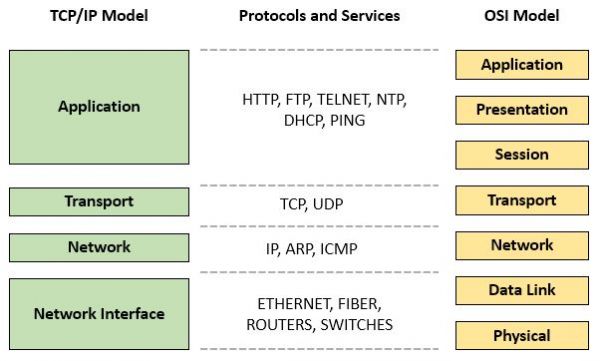TCP
https://www.geeksforgeeks.org/tcp-connection-termination/ https://packetlife.net/blog/2010/jun/7/understanding-tcp-sequence-acknowledgment-numbers/ sliding window, three way handshake
PAGE UNDER CONSTRUCTION!!!
Add notes: https://docs.google.com/document/d/1QaI4mHGB5_tPimuyBVQRROpx5ErqumGSWZEa12dANXU/edit
TCP header image; http://www.networksorcery.com/enp/protocol/tcp.htm
TCP/IP Model
TCP/IP Model - Transmission Control Protocol/Internet Protocol. The TCP/IP Model is a concise version of the OSI model. It contains four layers, unlike seven in the OSI model. The Internet protocol suite is the conceptual model and set of communications protocols used in the Internet and similar computer networks. It is commonly known as TCP/IP because the foundational protocols in the suite are the Transmission Control Protocol and the Internet Protocol.
The Four Layers of the TCP/IP Model in Comparison with OSI Model
4. Application Layer - Combines Session (5), Presentation (6), and Application (7) layers of the OSI. Protocols for email (SMTP), (FTP)
3. Transport Layer - Same as Transport (4) layer. Where TCP works by asking another device on the network if it is willing to accept info from the local device. Also UDP can be found here.
2. Internet Layer - Corresponds to the Network (3) layer. Internet Protocol (IP) uses IP addy, consisting of a Network Identifier and a Host Identifier, to determine the addy of the device it is communicating with.
1. Network Interface/Data Link Layer - Combines Physical (1) and Data link (2) layers and routes the data between devices on the same network. It also manages the exchange of data between the network and other devices.
Example of TCP/IP Model
4. User interacts with browser, sends request for: www.site.com. Application sends this message/request to the TCP program at the transport layer. Source: xxx.yyy.zzz. TCP is responsible for error-free delivery of the message to the destination host. (It will let the application program know if it cannot deliver the message for some reason).
3. TCP program adds header information to the message. Includes the address of source and destination, and an error checksum. And port info in this case its port 80. The TCP program then passes the message plus its new header to the IP program at the network/internet layer.
2. IP program adds another header, which contains only the information the routers need to deliver the packet to the destination host (IP source and dest., and TTL). The packet (larger envelope). At this point TCP has converted the domain names www.site.com and source xxx.yyy.zzz to IP addresses by using DNS (Domain name servers). TTL is the number of router hops the packet should go through before giving up and deciding that it cannot be delivered.
1. Packets are moved within the LAN from sending host to the router, by the hardware, software and firmware, at the Data link and physical layers at the bottom of this protocol stack. Each program in the stack adds its own header. They are removed (envelopes opened) at the receiving end.
